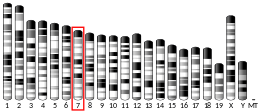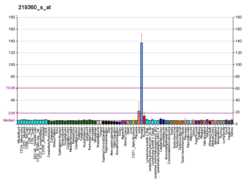TRPM4
Transient receptor potential cation channel subfamily M member 4 (hTRPM4), also known as melastatin-4, is a protein that in humans is encoded by the TRPM4 gene.[5][6]
TRPM4 Channel Blocker
- 9-Phenanthrol
gollark: With end to end encryption, the server cannot see your messages, so you don't need to trust it for anything but metadata, which is admittedly somewhat bee.
gollark: You can compile the app yourself?
gollark: No, Signal is open source so you can check the client code.
gollark: And you can't verify that it's not sending off messages containing ccertain keywords or something.
gollark: Anyway, WhatsApp is *allegedly* end to end encrypted, but you can't verify that.
See also
References
- GRCh38: Ensembl release 89: ENSG00000130529 - Ensembl, May 2017
- GRCm38: Ensembl release 89: ENSMUSG00000038260 - Ensembl, May 2017
- "Human PubMed Reference:". National Center for Biotechnology Information, U.S. National Library of Medicine.
- "Mouse PubMed Reference:". National Center for Biotechnology Information, U.S. National Library of Medicine.
- Xu XZ, Moebius F, Gill DL, Montell C (September 2001). "Regulation of melastatin, a TRP-related protein, through interaction with a cytoplasmic isoform". Proc. Natl. Acad. Sci. U.S.A. 98 (19): 10692–7. doi:10.1073/pnas.191360198. PMC 58528. PMID 11535825.
- Clapham DE, Julius D, Montell C, Schultz G (December 2005). "International Union of Pharmacology. XLIX. Nomenclature and structure-function relationships of transient receptor potential channels". Pharmacol. Rev. 57 (4): 427–50. doi:10.1124/pr.57.4.6. PMID 16382100.
Further reading
- Islam, Md. Shahidul (January 2011). Transient Receptor Potential Channels. Advances in Experimental Medicine and Biology. 704. Berlin: Springer. p. 700. ISBN 978-94-007-0264-6.
- Launay P, Fleig A, Perraud AL, Scharenberg AM, Penner R, Kinet JP (2002). "TRPM4 is a Ca2+-activated nonselective cation channel mediating cell membrane depolarization". Cell. 109 (3): 397–407. doi:10.1016/S0092-8674(02)00719-5. PMID 12015988.
- Launay P, Cheng H, Srivatsan S, Penner R, Fleig A, Kinet JP (2004). "TRPM4 regulates calcium oscillations after T cell activation". Science. 306 (5700): 1374–1377. doi:10.1126/science.1098845. PMID 15550671.
- Vennekens R, Nilius B (2007). "Insights into TRPM4 function, regulation and physiological role". Handb Exp Pharmacol. Handbook of Experimental Pharmacology. 179 (179): 269–85. doi:10.1007/978-3-540-34891-7_16. ISBN 978-3-540-34889-4. PMID 17217063.
- Vennekens R, Olausson J, Meissner M, Bloch W, Mathar I, Philipp SE, Schmitz F, Weissgerber P, Nilius B, Flockerzi V, Freichel M (2007). "Increased IgE-dependent mast cell activation and anaphylactic responses in mice lacking the calcium-activated nonselective cation channel TRPM4" (PDF). Nat Immunol. 8 (3): 312–320. doi:10.1038/ni1441. PMID 17293867.
- Barbet G, Demion M, Moura IC, Serafini N, Léger T, Vrtovsnik F, Monteiro RC, Guinamard R, Kinet JP, Launay P (2008). "The calcium-activated nonselective cation channel TRPM4 is essential for the migration but not the maturation of dendritic cells". Nat Immunol. 9 (10): 1148–56. doi:10.1038/ni.1648. PMC 2956271. PMID 18758465.
External links
- TRPM4+protein,+human at the US National Library of Medicine Medical Subject Headings (MeSH)
This article incorporates text from the United States National Library of Medicine, which is in the public domain.
This article is issued from Wikipedia. The text is licensed under Creative Commons - Attribution - Sharealike. Additional terms may apply for the media files.




